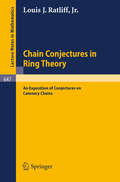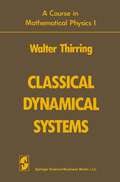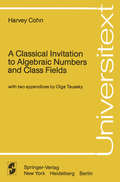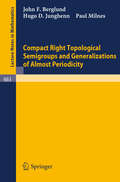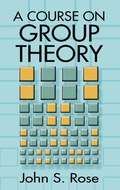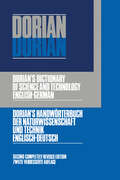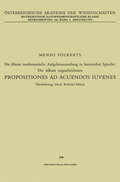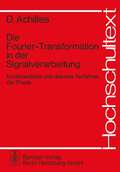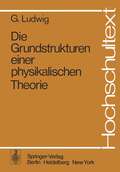- Table View
- List View
Chain Conjectures in Ring Theory: An Exposition of Conjectures on Catenary Chains (Lecture Notes in Mathematics #647)
by L.J. Jr. RatliffCharacterizations of Probability Distributions.: A Unified Approach with an Emphasis on Exponential and Related Models. (Lecture Notes in Mathematics #675)
by Janos Galambos Samuel KotzA Classical Invitation to Algebraic Numbers and Class Fields (Universitext)
by Harvey Cohn"Artin's 1932 Göttingen Lectures on Class Field Theory" and "Connections between Algebrac Number Theory and Integral Matrices"
Coding Theorems of Information Theory (Ergebnisse der Mathematik und ihrer Grenzgebiete. 2. Folge #31)
by J. WolfowitzThe objective of the present edition of this monograph is the same as that of earlier editions, namely, to provide readers with some mathemati cal maturity a rigorous and modern introduction to the ideas and principal theorems of probabilistic information theory. It is not necessary that readers have any prior knowledge whatever of information theory. The rapid development of the subject has had the consequence that any one book can now cover only a fraction of the literature. The latter is often written by engineers for engineers, and the mathematical reader may have some difficulty with it. The mathematician who understands the content and methods of this monograph should be able to read the literature and start on research of his own in a subject of mathematical beauty and interest. The present edition differs from the second in the following: Chapter 6 has been completely replaced by one on arbitrarily varying channels. Chapter 7 has been greatly enlarged. Chapter 8 on semi-continuous channels has been drastically shortened, and Chapter 11 on sequential decoding completely removed. The new Chapters 11-15 consist entirely of material which has been developed only in the last few years. The topics discussed are rate distortion, source coding, multiple access channels, and degraded broadcast channels. Even the specialist will find a new approach in the treatment of these subjects. Many of the proofs are new, more perspicuous, and considerably shorter than the original ones.
Combinatorial Mathematics: Proceedings of the International Conference on Combinatorial Theory, Canberra, August 16 - 27, 1977 (Lecture Notes in Mathematics #686)
by D. A. Holton J. SeberryCompact Right Topological Semigroups and Generalizations of Almost Periodicity (Lecture Notes in Mathematics #663)
by J. F. Berglund H. D. Junghenn P. MilnesCompetition for Space and the Structure of Ecological Communities (Lecture Notes in Biomathematics #25)
by P. YodzisThis volume is an investigation of interspecific competition for space, particularly among sessile organisms, both plant and animal, and its consequences for community structure. While my own contribu tion ----and the bulk of this volume --- lies in mathematical analysis of the phenomenon, I have also tried to summarize the most important natural historical aspects of these communities, and have devoted much effort to relating the mathematical results to observations of the natural world. Thus, the volume has both a synthetic and an analytic aspect. On the one hand, I have been struck by certain similarities among many communities, from forests to mussel beds, in which spatial com petition is important. On the other hand, I have analyzed this pheno menon by means of reaction-dispersal models. Finally, the mathematical analysis has suggested a conceptual framework for these communities which, I believe, further unifies and illuminates the field data. A focal perception of this work is that, just as niche relations provide an appropriate expression of the influence of resource compe tition on community structure, so do dominance relations provide an appropriate expression of the influence of spatial competition.
A Computational Method in Plasma Physics (Scientific Computation)
by F. Bauer O. Betancourt P. GarabedianCounterexamples in Topology
by L.A. Steen J.A. Jr. SeebachThe creative process of mathematics, both historically and individually, may be described as a counterpoint between theorems and examples. Al though it would be hazardous to claim that the creation of significant examples is less demanding than the development of theory, we have dis covered that focusing on examples is a particularly expeditious means of involving undergraduate mathematics students in actual research. Not only are examples more concrete than theorems-and thus more accessible-but they cut across individual theories and make it both appropriate and neces sary for the student to explore the entire literature in journals as well as texts. Indeed, much of the content of this book was first outlined by under graduate research teams working with the authors at Saint Olaf College during the summers of 1967 and 1968. In compiling and editing material for this book, both the authors and their undergraduate assistants realized a substantial increment in topologi cal insight as a direct result of chasing through details of each example. We hope our readers will have a similar experience. Each of the 143 examples in this book provides innumerable concrete illustrations of definitions, theo rems, and general methods of proof. There is no better way, for instance, to learn what the definition of metacompactness really means than to try to prove that Niemytzki's tangent disc topology is not metacompact. The search for counterexamples is as lively and creative an activity as can be found in mathematics research.
A Course in Differential Geometry (Graduate Texts in Mathematics #51)
by W. KlingenbergThis English edition could serve as a text for a first year graduate course on differential geometry, as did for a long time the Chicago Notes of Chern mentioned in the Preface to the German Edition. Suitable references for ordin ary differential equations are Hurewicz, W. Lectures on ordinary differential equations. MIT Press, Cambridge, Mass., 1958, and for the topology of surfaces: Massey, Algebraic Topology, Springer-Verlag, New York, 1977. Upon David Hoffman fell the difficult task of transforming the tightly constructed German text into one which would mesh well with the more relaxed format of the Graduate Texts in Mathematics series. There are some e1aborations and several new figures have been added. I trust that the merits of the German edition have survived whereas at the same time the efforts of David helped to elucidate the general conception of the Course where we tried to put Geometry before Formalism without giving up mathematical rigour. 1 wish to thank David for his work and his enthusiasm during the whole period of our collaboration. At the same time I would like to commend the editors of Springer-Verlag for their patience and good advice. Bonn Wilhelm Klingenberg June,1977 vii From the Preface to the German Edition This book has its origins in a one-semester course in differential geometry which 1 have given many times at Gottingen, Mainz, and Bonn.
A Course in Mathematical Physics 1: Classical Dynamical Systems
by Walter ThirringThis textbook presents mathematical physics in its chronological order. It originated in a four-semester course I offered to both mathematicians and physicists, who were only required to have taken the conventional intro ductory courses. In order to be able to cover a suitable amount of advanced materil;ll for graduate students, it was necessary to make a careful selection of topics. I decided to cover only those subjects in which one can work from the basic laws to derive physically relevant results with full mathematical rigor. Models which are not based on realistic physical laws can at most serve as illustrations of mathematical theorems, and theories whose pre dictions are only related to the basic principles through some uncontrollable approximation have been omitted. The complete course comprises the following one-semester lecture series: I. Classical Dynamical Systems II. Classical Field Theory III. Quantum Mechanics of Atoms and Molecules IV. Quantum Mechanics of Large Systems Unfortunately, some important branches of physics, such as the rela tivistic quantum theory, have not yet matured from the stage of rules for calculations to mathematically well understood disciplines, and are there fore not taken up. The above selection does not imply any value judgment, but only attempts to be logically and didactically consistent. General mathematical knowledge is assumed, at the level of a beginning graduate student or advanced undergraduate majoring in physics or mathe matics.
A Course in Mathematical Physics 2: Classical Field Theory
by Walter ThirringIn the past decade the language and methods ofmodern differential geometry have been increasingly used in theoretical physics. What seemed extravagant when this book first appeared 12 years ago, as lecture notes, is now a commonplace. This fact has strengthened my belief that today students of theoretical physics have to learn that language-and the sooner the better. Afterall, they willbe the professors ofthe twenty-first century and it would be absurd if they were to teach then the mathematics of the nineteenth century. Thus for this new edition I did not change the mathematical language. Apart from correcting some mistakes I have only added a section on gauge theories. In the last decade it has become evident that these theories describe fundamental interactions, and on the classical level their structure is suffi cientlyclear to qualify them for the minimum amount ofknowledge required by a theoretician. It is with much regret that I had to refrain from in corporating the interesting developments in Kaluza-Klein theories and in cosmology, but I felt bound to my promise not to burden the students with theoretical speculations for which there is no experimental evidence. I am indebted to many people for suggestions concerning this volume. In particular, P. Aichelburg, H. Rumpf and H. Urbantke have contributed generously to corrections and improvements. Finally, I would like to thank Dr. 1. Dahl-Jensen for redoing some of the figures on the computer.
A Course on Group Theory (Dover Books on Mathematics)
by John S. RoseThis textbook for advanced courses in group theory focuses on finite groups, with emphasis on the idea of group actions. Early chapters summarize presupposed facts, identify important themes, and establish the notation used throughout the book. Subsequent chapters explore the normal and arithmetical structures of groups as well as applications. Topics include the normal structure of groups: subgroups; homomorphisms and quotients; series; direct products and the structure of finitely generated Abelian groups; and group action on groups. Additional subjects range from the arithmetical structure of groups to classical notions of transfer and splitting by means of group action arguments. More than 675 exercises, many accompanied by hints, illustrate and extend the material.
Cyclotomic Fields (Graduate Texts in Mathematics #59)
by S. LangKummer's work on cyclotomic fields paved the way for the development of algebraic number theory in general by Dedekind, Weber, Hensel, Hilbert, Takagi, Artin and others. However, the success of this general theory has tended to obscure special facts proved by Kummer about cyclotomic fields which lie deeper than the general theory. For a long period in the 20th century this aspect of Kummer's work seems to have been largely forgotten, except for a few papers, among which are those by Pollaczek [Po], Artin-Hasse [A-H] and Vandiver [Va]. In the mid 1950's, the theory of cyclotomic fields was taken up again by Iwasawa and Leopoldt. Iwasawa viewed cyclotomic fields as being analogues for number fields of the constant field extensions of algebraic geometry, and wrote a great sequence of papers investigating towers of cyclotomic fields, and more generally, Galois extensions of number fields whose Galois group is isomorphic to the additive group of p-adic integers. Leopoldt concentrated on a fixed cyclotomic field, and established various p-adic analogues of the classical complex analytic class number formulas. In particular, this led him to introduce, with Kubota, p-adic analogues of the complex L-functions attached to cyclotomic extensions of the rationals. Finally, in the late 1960's, Iwasawa [Iw 1 I] . made the fundamental discovery that there was a close connection between his work on towers of cyclotomic fields and these p-adic L-functions of Leopoldt-Kubota.
Dictionary of Science and Technology: English-German
by UNKNOWN AUTHORDorian's Dictionary of Science and Technology: English-German, Second Revised Edition focuses on the compilation of terms employed in science and technology. The book first takes a look at abduction, aberration, abhesion, abating, ablation, abscission, coupling, covering, back iron, cross-breeding, clip, cleats, channel, circuit diagram, connection, conveyors, and supercharger. The manuscript then takes a look at dabbing, dacite, dactyl, daffodil, damp, earmark, earphone, ripening, current prospecting, facilities, gaff, gablet, galaxy, gale, gait, gall, and galipot. The publication ponders on haddock, Hadley quadrant, H-bomb, habitation, habituation, hemoglobin, hailstorm, hail, halation, ichnography, iceboat, oblate, oblique, electrode structure, obesity, oatmeal, dyeing, and pachyderm. The text then explores wainscoting, waist, wale, waiver, ultrafilter, ultrahigh frequency, ulocarcinoma, elongation, vaccinal fever, vaccination, vaccine, vacancy, and vacuometer. The text is a dependable source of data for researchers interested in the terms used in science and technology.
Die älteste mathematische Aufgabensammlung in lateinischer Sprache: Propositiones ad Acuendos Iuvenes (Denkschriften der Österreichischen Akademie der Wissenschaften #116 / 6)
by Menso FolkertsEine sehr reizvolle Aufgabe mathematikhistorischer Forschung besteht darin, die Geschichte bestimmter mathematischer Aufgabentypen und Lösungsmethoden zu erforschen. Es ist schon lange bekannt, daß oft dieselben Probleme zu verschiedenen Zeiten und in von einander weit entfernten Kulturkreisen behandelt wurden. Dabei nimmt man an, daß manche Probleme des augewandten Rechnens Bestandteil der Literatur vieler Völker sind, ohne daß man eine gegenseitige Beeinflussung vermuten darf. Wenn allerdings eine Aufgabe mit denselben nicht zu einfachen Zahlenwerten in verschiedenen Quellen überliefert wird, muß man an eine Abhängigkeit denken. Es ist jedoch auch in diesen Fällen gegenwärtig noch nicht möglich, zu sicheren Erkenntnissen über den Weg eines Problems zu gelangen; dazu sind die kulturellen Beziehungen zwischen den Völkern zu komplex und in den Einzelheiten zu wenig geklärt. Gemeinsam mit Mathematikhistorikern müßten hier Vertreter anderer historischer Disziplinen wie Wirtschafts- und Sozialgeschichte, aber auch die Philologen mitarbeiten. Eine solche Arbeit könnte dazu beitragen,_ die kulturellen Leistungen der be teiligten Völker, die Gemeinsamkeiten, aber auch die Unterschiede ihrer wissenschaftlichen Entwicklung herauszuarbeiten und dabei insbesondere den europazentrischen Standpunkt zu überwinden, der immer noch viele wissenschaftshistorische Darstellungen beherrscht. Als Vorarbeit für eine derart anspruchsvolle Untersuchung stellt sich dem Mathematik historiker zunächst die Aufgabe, die zahlreichen Sammlungen praktischer Mathematik zu untersuchen, festzustellen, wo das einzelne Problem oder die verwendete Methode sich erst mals findet, und - wenn möglich - Aussagen über Entstehung und Einfluß der betreffenden Sammlung zu machen. Gerade in den letzten Jahrzehnten sind hier neue Untersuchungen erschienen. So hat K.
Die amerikanische Stimmung im Jahr des Janus: Gemeinsame Sitzung der Klasse für Geisteswissenschaften und der Klasse für Natur-, Ingenieur- und Wirtschaftswissenschaften am 24. November 1976 in Düsseldorf (Rheinisch-Westfälische Akademie der Wissenschaften #226)
by Samuel R. SpencerDie Approximationseigenschaft lokaler Ringe (Lecture Notes in Mathematics #634)
by H. Kurke G. Pfister D. Popescu M. Roczen T. MostowskiDie Fourier-Transformation in der Signalverarbeitung: Kontinuierliche und diskrete Verfahren in der Praxis (Hochschultext)
by Dietmar AchillesDifferential Equations and Their Applications: Short Version
by M. BraunThis textbook is a unique blend of the theory of differential equations and their exciting application to ··real world" problems. First, and foremost, it is a rigorous study of ordinary differential equations and can be fully understood by anyone who has completed one year of calculus. However, in addition to the traditional applications, it also contains many exciting '·real life" problems. These applications are completely self contained. First, the problem to be solved is outlined clearly, and one or more differential equations are derived as a model for this problem. These equations are then solved, and the results are compared with real world data. The following applications are covered in this text. I. In Section 1.3 we prove that the beautiful painting ··Disciples at Emmaus" which was bought by the Rembrandt Society of Belgium for $170,000 was a modern forgery. 2. In Section 1.5 we derive differential equations which govern the population growth of various species, and compare the results predicted by our models with the known values of the populations. 3. In Section 1.6 we try to determine whether tightly sealed drums filled with concentrated waste material will crack upon impact with the ocean floor. In this section we also describe several tricks for obtaining informa tion about solutions of a differential equation that cannot be solved explicitly.
